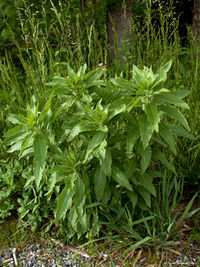Oenothera biennis
| See Also | Food Supplements |
|---|
| See Also | Botanical Monographs |
|---|
Evening Primrose (Oenothera biennis) is used to treat a range of conditions including digestive, immune and women's health concerns. To explore the characteristics, medicinal uses and prescribing considerations of this herb in more detail, check out the references indicated.[1], [2]
Contents
Characteristics
- Common Names: Evening primrose, King's cure all, Tree primrose, Sundrop
- Family: Onagraceae
- Habitat: Oenothera biennis is native to North America and is now found in many temperate climates. It thrives in open areas, especially dunes and sandy soil.
- Parts Used: Leaves, stem, bark, flowers, see (Evening primrose oil or EPO)
- Constituents: Fixed oil containing gamma-linolenic acid (GLA) and linoleic acid
- Medicinal Actions:
- Herb: astringent, sedative, phytoestrogen
- Oil:Hypotensive (via GLA, a prostaglandin E1 precursor), see Cardiac Tonic. Decreases PMS (tension and bloating), anti-inflammatory, nutritive, antiallergic,
Uses
Historical Uses:
Oenothera biennis was historically used by North American Native people for bruises, wounds, and asthma. It was used in Europe for gastrointestinal complaints, neuralgia, and whooping cough.
Medicinal Uses:
Herb
- Whooping cough, asthma
- Other Conditions
Oil
- PMS, mastalgia, and endometriosis
- Eczema (in diet, or externally), atopic dermatitis (especially with itching)
- rheumatoid arthritis, Sjögren's syndrome, multiple sclerosis, and ulcerative colitis
- pro-thromotic states, hypertension, intermittent claudication
- schizophrenia, hyperactivity in children, dementia
- Other Conditions
- Diabetic neuropathy, alcoholism, and obesity.
Prescribing Considerations
The information provided is intended to augment the treatment from a naturopathic doctor or other trained medical professional. Although most herbs are generally safe, it is recommended that you avoid self-prescribing especially when there is an underlying ongoing medical condition, if you are on any prescription medications or if you are pregnant or breastfeeding.
Formulations and Preparation
- Adult - 2-8g of seed oil daily in divided doses with food
- Children - 2-6g of seed oil daily in divided doses with food
Best administered with a preservative such as vitamin E, and protected from oxidation
- Tincture - 1-15 drops (98%)
Safety
The safety and prescribing considerations for this herb include:[3], [4]
- Generally regarded as safe.
- Side-effects are rare and limited to headache, nausea, and diarrhea. May also cause inhibition of testosterone conversion to dihydrotestosterone.
- Cautions and Contraindications
- epilepsy and mania (speculative)
- Drug-Herb Interactions.[2]
- Tamoxifen - faster response to the drug in patients with estrogen-dependent breast cancer (human study)
- Anticoagulants - may be potentiated (speculative)
- Phenothiazines - when given for schizophrenia, seizures were reported (human study; however, in other case reports patients diagnosed with schizophrenia and treated with phenothiazines were later rediagnosed with having epilepsy)
- Antiepileptics - may be less effective due to increased risk for seizure (speculative)
- Colchicine - synergistic in multiple sclerosis for improvement of disability score (human study)
- NSAIDs - reduced pain from NSAID-induced gastrointestinal lesions (human study)
References
- ↑ Boon Heather, Smith Michael (2009) 55 Most Common Medicinal Herbs: The Complete Natural Medicine Guide Second Edition Institute of Naturopathic Education and Research, CCNM Toronto.
- ↑ 2.0 2.1 Godfrey Anthony, Saunders Paul, Barlow Kerry, Gowan Matt (2011) Principles and Practices of Naturopathic Botanical Medicine, Advanced Botanical Medicine. V3 CCNM Press, Toronto.
- ↑ Stargrove Mitchell Bebell, Treasure Jonathan, McKee Dwight L (2008) Herb, Nutrient and Drug Interactions: Clinical Implications and Therapeutic Strategies.
- ↑ Brinker Francis (1997) Herbal Contraindications and Drug Interactions: Plus Herbal Adjuncts With Medicines, 4th Edition Eclectic Medical Publications.
